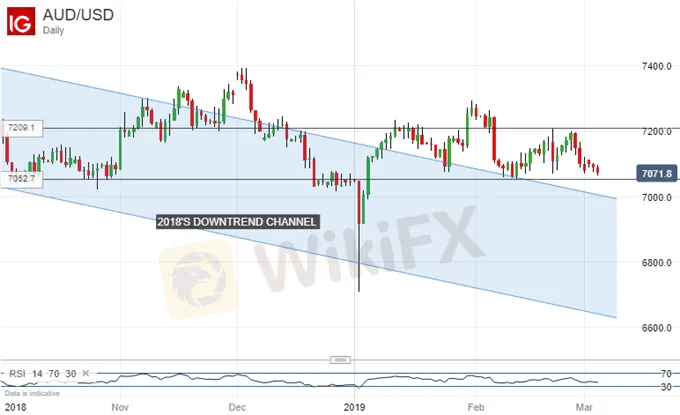简体中文
繁體中文
English
Pусский
日本語
ภาษาไทย
Tiếng Việt
Bahasa Indonesia
Español
हिन्दी
Filippiiniläinen
Français
Deutsch
Português
Türkçe
한국어
العربية
Australian Dollar Ticks Up As RBA Holds Rates, Lowe Speech Up Next
Abstract:The Australian Dollar rose initially after the Official Cash Rate was left on hold at 1.50% as had been very widely expected. RBA Governor Philip
Australian Dollar, RBA Monetary Policy Decision, Talking Points:
AUD/USD rose briefly following the RBAs decisio
Its statement offered no change from previous recent efforts, but was certainly no more dovish
Australian rates are clearly going nowhere soon, and markets still price in a cut as next move
Join our analysts for live, interactive coverage of all major economic data at the DailyFX Webinars. Wed love to have you along.
The Australian Dollar made modest immediate gains on Tuesday following the Reserve Bank of Australias decision to leave interest rates alone yet again. The Official Cash Rate thus stays at the record, 1.50% record low in place since August 2016.
The RBAs accompanying statement went very much with the form of recent months. It noted low, stable inflation, labor market strength and the increase in global downside risks. Governor Philip Lowe will probably add more detail later as he is scheduled to speak in Sydney on Wednesday.
AUD/USD rose in the immediate aftermath of the decision, possibly on some relief that the RBA has not become any more dovish in its outlook. However, those gains were short-lived and there was little here to suggest that Australian rates are going anywhere soon.

On its broader, daily chart AUD/USD remains above the downtrend channel which characterized much of 2018 as US interest rates rose and Australian rates remained stuck. Aussie bulls have benefitted this year from a rethink about the Federal Reserves intentions, and also from the stoking of risk appetite occasioned by expectations of a durable trade settlement between China and the US.

Still, the Australian Dollar would appear to lack interest rate support of its own, with domestic futures markets pricing in a quarter point cut to the Official Cash Rate by April of next year. With inflation still stubbornly below the RBAs 2% target this seems unlikely to change anytime soon. While overall risk appetite is likely to play its part in AUD/USD direction, it is notable that the pair has been stuck in a new overall downtrend since late January.
Disclaimer:
The views in this article only represent the author's personal views, and do not constitute investment advice on this platform. This platform does not guarantee the accuracy, completeness and timeliness of the information in the article, and will not be liable for any loss caused by the use of or reliance on the information in the article.
Read more

All Round Major Pairs Technical Analysis: EUR/USD, AUDUSD, And GBPUSD
The start of November has been a dwindling moment for the general major currency market. As essential economic updates flood the surface of the entire foreign exchange market, in which most of the currency pairs especially the major pairs were greatly affected by the impact of the economic releases. However, the US dollar was discovered to have held the main currency exchange performance metrics as the central economic updates from the US region tend to have determined the significant changes that have occurred in the major currency market so far.

Currencies wait for RBA to kick off big central bank week
The dollar hovered below recent highs on Tuesday as traders waited for the Reserve Bank of Australia to lead a handful of central bank meetings set to define the rates outlook this week.

US Dollar Holds Gains as Japan Boosts and China PMI Weighs. USD Volatility Ahead?
US DOLLAR, JAPAN ELECTION, USD/JPY, CHINA PMI, AUD/USD - TALKING POINTS

Australian Dollar Price Chart: AUD/USD Reversal Stalls– Trade Outlook
The Australian Dollar is up more than 2.6% on the back of a five-day rally with price eyeing initial resistance. These are the levels that matter on the AUD/USD charts.
WikiFX Broker
Latest News
TradingView Brings Live Market Charts to Telegram Users with New Mini App
Trump tariffs: How will India navigate a world on the brink of a trade war?
Interactive Brokers Launches Forecast Contracts in Canada for Market Predictions
Authorities Alert: MAS Impersonation Scam Hits Singapore
Stocks fall again as Trump tariff jitters continue
INFINOX Partners with Acelerador Racing for Porsche Cup Brazil 2025
Regulatory Failures Lead to $150,000 Fine for Thurston Springer
April Forex Trends: EUR/USD, GBP/USD, USD/JPY, AUD/USD, USD/CAD Insights
March Oil Production Declines: How Is the Market Reacting?
Georgia Man Charged in Danbury Kidnapping and Crypto Extortion Plot
Currency Calculator







